Traditional Estonian cuisine has substantially been based on meat and potatoes, and on fish in coastal and lakeside areas. However, it now shows influences from a variety of international cuisines and ingredients, with a number of contributions from the traditions of nearby countries. German, Swedish, Russian, Finnish and other influences have played their part. The most typical foods in Estonia have been rye bread, barley, pork, fish, potatoes and dairy products. In terms of staple food, Estonia is similar to other countries in the Baltic Sea Region.
Cold table

The first course in traditional Estonian cuisine is based on cold dishes — a selection of pickles, meats and sausages served with potato salad (kartulisalat) or rosolje, an Estonian signature dish almost identical to Swedish sillsallad, based on beetroot, potatoes and herring. Small pastries called pirukad (pirukas in the singular) filled with meat, fish, cabbage, carrots, and other fillings or mixtures are also popular, and are often served with puljong (bouillon broth). Herring is common among other fish as a part of the Estonian cold table. Smoked or marinated eel, as well as crayfish, are considered delicacies. One of Estonia's national dishes is the diminutive Baltic herring (räim), the national fish of the country, along with the sprat (kilu). Spiced salted sprats on an open sandwich (kiluvõileib) have been popularised as a distinctive Estonian appetiser.
Sõir is a cooked mixture of milk, cottage cheese and eggs.
Soups
Soups traditionally formed a main meal option and nowadays are more often eaten as first course. Soups are typically made of meat or chicken stock mixed with a variety of vegetables, eggs, pork or fish. Soups are also blended with sour cream, or milk. Pea soup is also quite popular. The soups like referenced below, are still popular and are sold en masse in cans in grocery stores as quick everyday meals. Lõhesupp, a creamy soup which seems to lean more towards local Haute cuisine made with salmon, potatoes and cream, has gained popularity recently.
Käkisupp is balls of fried pork with lard, mixed with barley flour, cooked into soup.
Main course
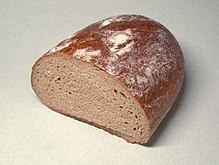
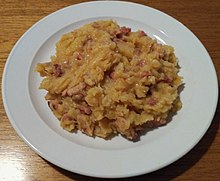

Black bread leib (or rukkileib, i.e "rye bread") accompanies almost every savory food in Estonia. Estonians continue to value their varieties of black rye-based bread.
Mulgikapsad (sauerkraut with pork and pearl barley) is one food that is added in the list of the Estonian cultural heritage and can be considered to be Estonian national food.
Mulgipuder is the only Estonian national food that is in the UNESCO List of the Intangible Cultural Heritage of Humanity.
The main dishes are probably the most eclectic part of modern Estonian cuisine, because many different dishes are tried.
Desserts
Typical Estonian desserts include kohupiimakreem (creamy curd), kohuke (curd snack), kama, kompott and less popular mannavaht (a cream made of semolina and juice or fruit). Estonian dessert leivasupp ("bread soup"), which is a type of sweet soup that is made of black bread and apples, normally served with sour cream or whipped cream, often seasoned with sugar is almost identical to the Latvian dish maizes zupa. Rhubarb pies are also a favorite.
Pastries or pies like the cinnamon bun, cardamom bun and different curd buns are also eaten, mostly accompanied by coffee. Another popular dessert is kringel (kringle), a sweet yeast bread often flavored with cardamom. Pancakes (pannkook, plural pannkoogid) are also traditional, common and popular. Vastlakukkel, a cardamom-spiced bread roll with whipped cream is a traditional Estonian sweet roll, it is eaten during the festivities of vastlapäev.
Mulgikorp is small round flatbreads or pastries covered with semolina or cottage cheese.
Drinks
Nowadays, locally brewed beer is the number one choice to accompany food; coffee, different juices or simply water being the main non-alcoholic choice. Tea and herbal teas are also drunk. Wine is the second most widely drunk alcoholic beverage, however its consumption in liters is overshadowed by the beer consumption that is roughly 5 times more than the consumption of wine or consumption of all the spirits. There are also Estonian fruit wines made of apples or different berries. Estonia is also known for locally produced viin (vodka) and other distilled spirits. Mead (mõdu), the alcoholic drink that was most popular in ancient times, has almost completely disappeared.
Some other drinks whose popularity peaked in the 20th century, however are still consumed by some Estonians, include kali (similar to kvass) and birch sap (kasemahl) beverages.
Besides milk (piim) other widely consumed dairy products include keefir and also hapupiim ("sour milk") and pett, which are variations on the theme of buttermilk.
Yogurt, which was not produced in Estonia before the restoration of independence, has become a very popular everyday food, which is mostly sold sweetened and in both a liquid form and a creamier version.
Hapurokk is a food made of fermented rye, also available as a drink.
Seasons
Summer and spring
Traditionally in summer and spring, Estonians like to eat everything fresh—berries, herbs, vegetables and everything else that comes straight from the garden. Hunting and fishing were common in history. Nowadays, they have remained as popular pastimes. It is popular to barbecue in the summer. Eggs are painted and eaten during Easter.
Winter and Christmas
During the winter months, jam, preserves and pickles are brought to the table. In the not so distant past, the gathering and conserving of fruits, edible mushrooms and vegetables for winter was more common, nowadays it is less so as almost everything can be bought from stores. However, preparing food for winter is still popular in the countryside and continues to retain its charm for many, as opposed to the commercialization of eating habits.
Oven-grilled pork, blood sausage (verivorst), roast goose (jõuluhani), jellied pork (sült), sauerkraut (hapukapsas) with oven-roasted potatoes, and mulled wine (hõõgvein, or glögi) have been part of the traditional Estonian menu that nowadays are mostly Christmas specialties. Also, typical Christmas treats have been apples, mandarin oranges, gingerbread, pickled pumpkin (kõrvitsasalat), and lingonberry jam.
History
Since the spread of farming, the most important food had become foods made from cereals: puder (porridge), rokk, leem and others. The oldest types of cereals grown in Estonia are barley and wheat. The most important turned out to be dark rye bread made from leavened dough, that started to be baked about a thousand years ago and became synonymous with food in the figurative sense. In addition to bread, a dish made from unleavened barley dough was baked called karask, in later times sepik was also made from wheat flour, and a white wheat bread sai was served on holidays. Turnip was also staple food in Estonia before potato and among other vegetables, cabbage and rutabaga were well-known for a long time. Potato cultivation started in Estonia in the middle of the 18th century, and starting from the end of the 19th century it became a dominant part of the daily Estonian diet. By the first half of the 20th century, Estonia was either the first (or second after Poland) in the world in terms of potato production per capita.
Until the 20th century, meat was not a frequent item on the menu of Estonian commoners. Farmers would slaughter animals in the autumn and the pig's head and legs were cooked into a dish called sült. Silk (Baltic herring) was a fish dish that was eaten salted and was much more common than a meat dish on the common people's table. Fresh fish was usually available on the sea coast and by larger lakes.
The food selection of the rural population was influenced by the cuisine of the local Baltic German landowners and the wealthier urban class, which was more diverse.
There are still some differences between the cuisines of the two historical regions of Estonia: Southern Estonia, where the farmers were somewhat more prosperous and enjoyed a more diverse cuisine compared to Northern Estonia. For example, kama, kohupiim (Quark (dairy product)), sõir (a dish similar to cheese) and various dishes made from legumes originate from Southern Estonia.
In the second half of the 19th century, along with property relations and economic conditions, eating habits also began to change in Estonia. Gradually, new foods and food preparation methods became known and available. The main international influences came from Germany and Russia through towns and estates. Semolina, rice, sugar, coffee and spices appeared in shops.
In the 1920s and 1930s, a second layer of Estonian cuisine developed in the newly independent country. Since then, such typical dishes in Estonia as the pickled cucumber, pickled pumpkin, liver pate, cutlets, mashed potatoes, Olivier salad, cabbage rolls, kissell, semolina foam, and flat cakes have become well known.
During the period of Soviet occupation (1944-1991), the Estonian daily diet was markedly influenced by what ingredients were available in, and also what new culinary ideas arrived from, the USSR: borš, seljanka, rassolnik, pelmeenid, hartšoo, etc. arrived in canteens and restaurants, whereas šašlõkk appeared in more private events. At the same time, the limited selection of food and especially condiments was felt. At the Soviet time, Estonians "invented" several desserts that would most commonly be eaten during birthdays, e.g kirju koer (cacao and butter mixed with crumbled cookies and marmalade, put in the freezer overnight) and kass Artur (soft toffee and butter mixed with fluffy corn sticks, frozen overnight).
It has been argued that since Estonia regained independence in 1990s, the local traditional cuisine has been losing its importance. However, during the most important holidays and celebrations, traditional foods are still preferred in families and among friends.
Gallery
-
 Mulgikapsad with potatoes.
Mulgikapsad with potatoes.
-
 Bread retailed from street counters in Tallinn (photo from The Encyclopedia of Food by Artemas Ward, 1923).
Bread retailed from street counters in Tallinn (photo from The Encyclopedia of Food by Artemas Ward, 1923).
-
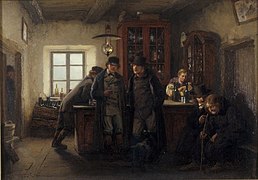 Estonian farmers in an inn, drinking viin (vodka), painting by Oskar Hoffmann, 1899.
Estonian farmers in an inn, drinking viin (vodka), painting by Oskar Hoffmann, 1899.
-
 Rye bread (leib) with garlic is also eaten as a pub snack.
Rye bread (leib) with garlic is also eaten as a pub snack.
-
 Small oven-cooked verivorst blood sausages
Small oven-cooked verivorst blood sausages
-
Traditional sausages at display in an Estonian street market, 2013.
-
World's largest kiluvõileib fish sandwich was created in 2014 in Tallinn.
-
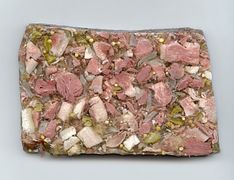 Sült (pieces of meat in jellied pork brawn).
Sült (pieces of meat in jellied pork brawn).
-
Onions and dried fish for sale on a farmer's roadside stand.
-
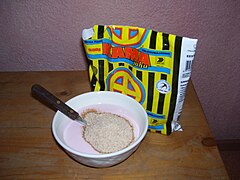 Kama, a cereal and legume flour is traditionally eaten mixed with just milk or buttermilk, now also used for making desserts.
Kama, a cereal and legume flour is traditionally eaten mixed with just milk or buttermilk, now also used for making desserts.
Notes and references
- Eesti Toit infoserver v2.0.3.0 Archived December 17, 2007, at the Wayback Machine
- "Eesti toidukultuur".
- ^ Estonia By Michael Spilling
- "Sõira tegemine Vana-Võromaal". Eesti Rahvakultuuri Keskus.
- "Creamy Salmon Soup | Estonian Dairy Association". Retrieved 2024-11-09.
- "Käkisupi keetmine ja söömine Hiiumaal". Eesti Rahvakultuuri Keskus.
- "Mulgi kapsaste valmistamine ja söömine Mulgimaal". Eesti Rahvakultuuri Keskus.
- "Cooking and eating Mulgi puder, traditional mashed potato with barley in the Mulgimaa region, Estonia". UNESCO List of the Intangible Cultural Heritage of Humanity. 2024.
- Rosa, Natalia (27 February 2020). "A first timer's guide to wholesome and delicious Estonian Food". Trafalgar.com. Retrieved 13 May 2023.
- "Mulgi korbi valmistamine ja söömine Mulgimaal". Eesti Rahvakultuuri Keskus.
- "Alcohol market, consumption and harms in Estonia Yearbook 2022".
- "Hapuroka tegemine ja söömine Kihnus". Eesti Rahvakultuuri Keskus.
- Krinal, Valner. Eesti majandusajalugu (History of the Estonian economy).Tartu: 1992, p. 10 (in Estonian).
- "Ellen Pärn. Rukkileib - eestlase põhitoit" (PDF).
- Moora, Aliise. Eesti talurahva vanem toit II (Estonian peasant food in the older period, Vol II). Tallinn: Valgus (publisher), 1991, p. 283 (in Estonian).
- "Eesti Entsüklopeedia, article Kartul".
- "Eesti toidukultuur.Talupojaköök".
- Moora, Aliise. Eesti talurahva vanem toit I (Estonian peasant food in the older period, Vol I). Tallinn: Valgus (publisher), 1980, p. 157 (in Estonian).
- "Raekoja platsil valmib maailma pikim kiluvõileib". Tallinn. Postimees (in Estonian). 14 May 2014. Archived from the original on 13 October 2016. Retrieved 13 October 2016.
External links
- Karin Karner's book "Estonian Tastes And Traditions"
- International Wine and Food Society Estonian Branch
- Estonian Kitchen: 5 Local Dishes You Probably Didn’t Think of Trying
- Traditional Estonian Cooking e-book
| European cuisine | |||||
|---|---|---|---|---|---|
| Sovereign states |
| ||||
| States with limited recognition | |||||
| Dependencies and other territories | |||||
| Cuisines | |||||||||||||
|---|---|---|---|---|---|---|---|---|---|---|---|---|---|
| Continental |
| ||||||||||||
| National and regional |
| ||||||||||||
| Ethnic |
| ||||||||||||
| Religious | |||||||||||||
| Historical |
| ||||||||||||
| Styles | |||||||||||||
| Lists | |||||||||||||
| Related | |||||||||||||
